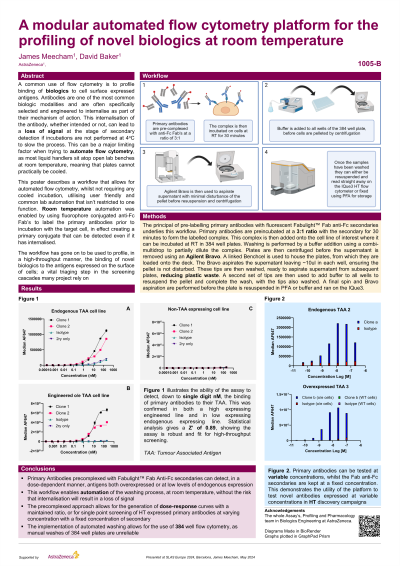Screening Applications & Diagnostics
Poster Session B
(1005-B) A modular automated flow cytometry platform for the profiling of novel biologics at room temperature.
Wednesday, May 29, 2024
10:30 - 11:15 CEST
Location: Exhibit Hall


James Meecham (he/him/his)
Senior Scientist
Astrazeneca
Cambridge, England, United Kingdom
Poster Presenter(s)
Abstract: A common use of flow cytometry is to profile binding of biologics to cell surface expressed antigens. Antibodies are one of the most common biologic modalities and are often specifically selected and engineered to internalise as part of their mechanism of action. This internalisation of the antibody, whether intended or not, can lead to a loss of signal at the stage of secondary detection if incubations are not performed at 4oC to slow the process. This can be a major limiting factor when trying to automate flow cytometry, as most liquid handlers sit atop open lab benches at room temperature, meaning that plates cannot practically be cooled.
This poster describes a workflow that allows for automated flow cytometry, whilst not requiring any cooled incubation, utilising user friendly and common lab automation that isn’t restricted to one function. Room temperature automation was enabled by the use of fluorophore conjugated anti-Fc Fab’s to label the primary antibodies prior to incubation with the target cell, in effect creating a primary conjugate that can be detected even if it has internalised.
The workflow has gone on to be used to profile, in a high-throughput manner, the binding of novel biologics to the antigens expressed on the surface of cells; a vital triaging step in the screening cascades many project rely on.
This poster describes a workflow that allows for automated flow cytometry, whilst not requiring any cooled incubation, utilising user friendly and common lab automation that isn’t restricted to one function. Room temperature automation was enabled by the use of fluorophore conjugated anti-Fc Fab’s to label the primary antibodies prior to incubation with the target cell, in effect creating a primary conjugate that can be detected even if it has internalised.
The workflow has gone on to be used to profile, in a high-throughput manner, the binding of novel biologics to the antigens expressed on the surface of cells; a vital triaging step in the screening cascades many project rely on.
